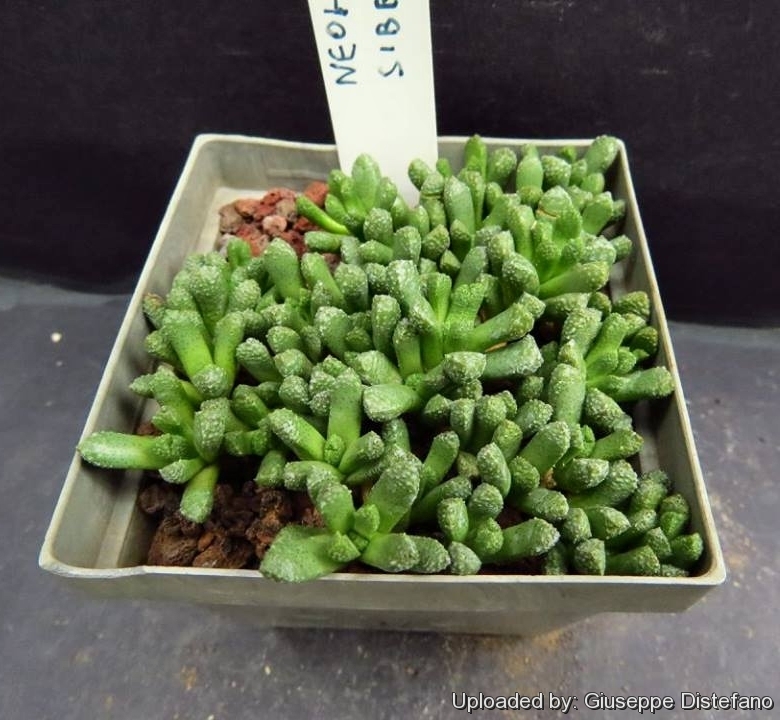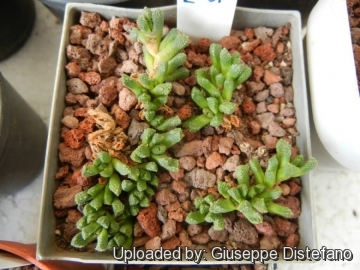




Your support is critical to our success.

Origin and Habitat: Neohenricia sibbettiiSN|26296]]SN|26296]] is a South African endemic occuring with a patchy distribution from Victoria West in the Great Karoo to Fauresmith in the Free State Province, and localised in the Eastern Cape.
Altitude: 1120 - 1380 metres above sea level.
Habitat and Ecology: It grows in crevices or shallow gritty pans on sandstone, rarely on dolerite. The climate is dry and hot in summer with 200-400 mm rainfall p.a., mainly in March and November.
Synonyms:
- Neohenricia sibbettii (L. Bolus) L. Bolus
- Henricia sibbettii (L. Bolus) L. Bolus
- Mesembryanthemum sibbettii L. Bolus
Description: Neohenricia sibbettiiSN|26296]]SN|26296]] is a a tiny cryptic succulent with minuscule club-shaped leaves with a flat or (in cultivation) roundish rugose top. It is one of the smallest species in the huge Mesembryanthemum family and can make a very impressive mound if grown nicely; they are most impressive under the closeup lens.
Remarks: Neohenricia is a small (tiny) cousin of similar looking species like Titanopsis, Aloinopsis, Rhinephyllum all with rough leaves but its tiny flowers on summer nights exhale a powerful tropical fragrance, perhaps the finest odour of all Mesembs — mixture of pineapple,coconut, and something musky. The collective scent can be detected many metres apart. What is really interesting that at the beginning the colour of the flowers is whitish or greenish not lilac or purple. But after a day or two it becomes normal purple colour.
Habit: It is a perennial carpet-like to creeping plant forming low mats up to 30 cm in diameter and about 1 cm tall.
Stems: Branched short, bearing 2 pairs of leaves, rooting at nodes, the adventitious roots a little thickened.
Leaves: Tiny, club-shaped, ascending, less than 10 mm long and 4 mm in diameter, the top flat or rounded above, convex below, joined at the base, epidermis with conspicuous raised warts, the warts arranged in spirals or meanders on the top and on the upper 1/2 of the leaf length, or petering out into distant warts on the sides. Wax as a continuous wartlike crustose outgrowths over the epidermis, with opaque idioblasts scattered among them and very few tiny particles on the rugose surface. Leaves usually are brown greyish green, and in nature mimics the surrounding gravel very well.
Flowers: Small (15-17 mm in diameter), solitary, nocturnal, looking like a little star, pedicellate, bracteoles almost as big as the foliage leaves, petals white to pale green, in some populations entirely or apically purple, filamentous staminodes absent, filaments white to yellow, with 5 nectaries in a ring at the upper rim of a low hypanthium, below the bases of the epapillate filaments. The ovules have basal or parietal placentation, not central.
Blooming season: Flowers begin to open at dusk in the late Spring to Summer and have light delicate scent.
Fruits (Capsules):*** 5-chambered, approx 3 mm in diameter, falling off early, base bowl-shaped, top almost flat. There are no closing bodies.
Notes: This fascinating mat forming mesemb with warty leaves. Because it's a winter grower it is often used as a ground cover for winter growing succulent bonsai such as Tylecodon, Sarcocaulon, and even Pachycormus.
Bibliography: Major references and further lectures
1) Heidrun E.K. Hartmann “Illustrated Handbook of Succulent Plants: Aizoaceae F-Z” Springer, 2002
2) van Jaarsveld, E., Potter, L. & Raimondo, D. 2007. Neohenricia sibbettii (L.Bolus) L.Bolus. National Assessment: "Red List of South African Plants" version 2013.1. Accessed on 2014/03/30
3) Doreen Court “Succulent Flora of Southern Africa” CRC Press, 01/giu/2000
4) Gordon D. Rowley “The illustrated encyclopedia of succulents” Crown Publishers, 01/ago/1978
5) Gideon Smith “Mesembs of the World: Illustrated Guide to a Remarkable Succulent Group.” Briza Publications, 1998
6) Journal of South African Botany. Kirstenbosch 4: 51, 1938

Neohenricia sibbettii Photo by: Giuseppe Distefano
The gallery now contains thousands of pictures, however it is possible to do even more. We are, of course, seeking photos of species not yet shown in the gallery but not only that, we are also looking for better pictures than those already present. Read More...
Cultivation and Propagation: Neohenricia sibbettiiSN|26296]]SN|26296]] is a "winter grower" which is most active in autumn and early spring and heading for summer dormancy, but in favourable growing conditions it keeps going over the summer too and doesn't need particular care. It should be grown in smallest pots or trays and is very active in summer. It is quite hardy and can take a light frost and in dry warm-temperate regions these succulents make very impressive out door ground covers.
Growing rate: It is vigorous and quick-growing, speedily forming lateral shoots and low mats.
Soil: It needs a well-drained soil mix, but can tolerate a wide variety of soil types and growing locations. Requires good drainage as it it is prone to root rot. It can grows outdoor in sunny, dry, rock crevices (protection against winter wet is required) It can also be cultivated in alpine house, in poor, drained soil.
Fertilization: Feed it once during the growing season with a fertilizer specifically formulated for cactus succulents (poor in nitrogen), including all micro nutrients and trace elements diluted to ½ the strength recommended on the label. It thrives in poor soils and need a limited supplies of fertilizer to avoid the plants developing excess vegetation, which is easily attacked by fungal diseases.
Watering: They are not at all delicate and can take some water year-round, but the challenge is to help them keep their compact form and prevent elongation of the stem. Water minimally in winter, only when the plant starts shrivelling, water more abundantly when they are growing in the spring and autum, but let the soil dry between soaking. An occasional summer soaking is wise. If grown in a container, bottom watering by immersing the container is recommended. They must have very dry atmosphere.
Maintenance: The stems root as the plant travels underground, with older leaves dying off, so it may be necessary to cleaning once every few years.
Light: It needs a bright sunny exposure in winter, but keep cool and partially shaded in summer.
Hardiness: It prefer a very bright situation and require a minimum temperature 0°C (But will take frost and is hardy down to -7° C for short periods if it is in dry soil ).
Uses: Container, rock garden.
Pests & diseases: Neohenricia may be attractive to a variety of insects, but plants in good condition should be nearly pest-free, particularly if they are grown in a mineral potting-mix, with good exposure and ventilation. Nonetheless, there are several pests to watch for:
- Red spiders: Red spiders may be effectively rubbed up by misting the vulnerable plants every day.
- Mealy bugs: Occasianlly Mealy bugs develop aerial into the new leaves and flowers with disfiguring results, but the worst types develop underground on the roots and are invisible except by their effects.
- Sciara Flies: Sciara Flies are one of the major problems for seedlings. It is a good practice to mulch your seedlings with a layer of grit, which will strongly discourage the flies.
- Scales, thrips and aphids: This insects are rarely a problem.
It is wise to treat your whole collection with a systemic insecticide twice a year in spring and autumn.
- Rot: Rot is only a minor problem with mesembs if the plants are watered and “aired” correctly. If they are not, fungicides won't help all that much.
Propagation: It is very easy to start from seed or cuttings. Seeds germinate in 7-14 days at 21°C in spring. To make a cutting twist off a branch with at least a part of roots and permit it to dry out a couple of days, lay it on the soil and insert the stem end partially into the soil. Try to keep the cutting somewhat upright so that the roots are able to grow downward.
| Your Actions | |
|---|---|
| Back to Neohenricia index | |
| Back to Aizoaceae index | |
 |
Back to Succulents Encyclopedia index |
Privacy stantement - Terms and conditions - How to cite - About us - Feedback - Donate



